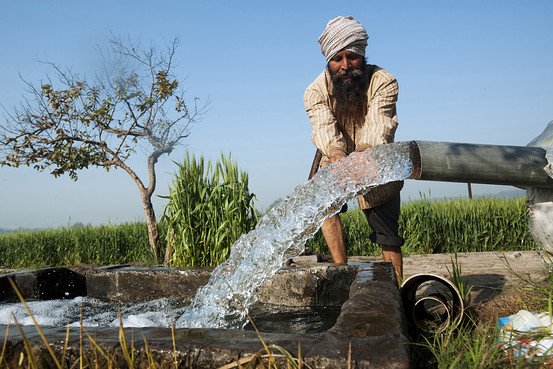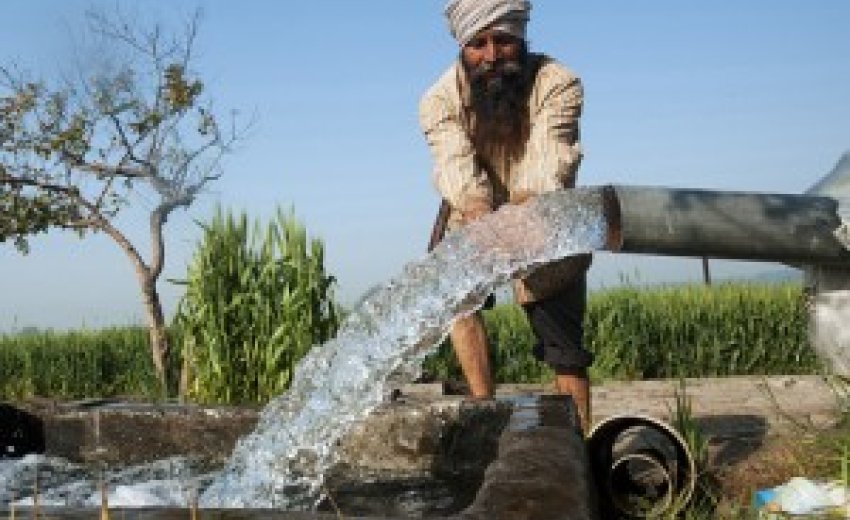TARN TARAN, India—India's northern state of Punjab was once a symbol of the nation's economic progress, its advances in agriculture lauded world-wide as a spectacular feat that made India self-sufficient in food production.
 |
| Manpreet Romana for The Wall Street Journal A farm worker drinks water from a electric tube well at a farm in Khudani Kalan, a village 25 kilometers from the city of Ludhiana, Punjab, on March 14, 2011. Over-usage of ground water by Punjabi farmers growing wheat and rice has led to a drastic fall in the water table across the state. |
But Punjab today faces a grave economic crisis, the result of years of shoddy governance that have stunted growth and created such a mound of public debt that the state is now seeking a multi-billion dollar bailout from the central government. It also is facing high unemployment, an anomaly in a nation that has the highest economic growth rate of any major nation after China.
Once India's fastest growing state, Punjab is now one of its slowest, with about 6% economic expansion annually in recent years, compared with a national average of 8.5% and top-performing regions that are clocking 11% growth. With few good industry jobs being created, urban unemployment is a staggering 15.2%.
The state's decline highlights some of the risks facing India itself. Many of the problems behind Punjab's decline—an overreliance on agriculture, the underdevelopment of manufacturing, lack of infrastructure development and overspending on populist welfare subsidies—are major issues for the government in New Delhi.
Just as corruption allegations against the national government have paralyzed the ruling Congress Party-led coalition, allegations in Punjab in recent days that a state legislator accepted a bribe to take sides in a major land dispute have spawned a scandal that could force a shake-up in the state government.
Punjab's struggles offer one scenario of what might happen next in India if the central government doesn't address longstanding challenges. The state's woes also are a stark warning that rapid economic growth can't be taken for granted, even in regions that have long been star performers.
India's future is normally framed as a question of whether chronically poor states will make major leaps in development or remain mired in poverty. But Punjab's experience raises the worrying possibility that long-successful states could lurch backward and become a national drag.
Amid the turmoil in Punjab, the state's ex-finance minister, Manpreet Singh Badal, has emerged as a leading advocate of reforms. He was sacked from his post last October and expelled from the ruling party—which is run by his cousin—after publicly criticizing the government's handling of the economy and public finances.
Mr. Badal says Punjab needs to reduce spending on populist programs such as free power for farmers and cash handouts to lower-caste women who get married; make long-term investments in education and infrastructure; and provide more incentives for industrial development.
"We have to think about not just the next general election, but the next generation," Mr. Badal said in a recent interview. The 48-year-old politician, who remains a state legislator, was touring the state to promote a new political party to contest next year's state assembly polls.
| Manpreet Singh Badal used to be finance minister in Punjab, but was sacked for publicly criticizing his own government. As other India states forge ahead, Badal warns, Punjab is falling behind due to poor governance and wasteful spending. WSJ's Amol Sharma reports. |
"After listening to the speech I feel that he will do something, but whoever sits on the seat of power forgets all promises later," said Pawanjit Singh, a 28-year unemployed college graduate.
Critics, including some top government officials, have said Mr. Badal is exaggerating the state's economic problems. Punjab is still among India's richest states in terms of per-capita income. And they say he was in a position to help the state as finance minister for four years. A spokesman for Punjab's chief minister didn't respond to requests for comment.
With little spending restraint and paltry tax collections, Punjab has amassed $15.5 billion in debt. To pay annual debt servicing costs of about $1.8 billion, salaries for government workers and maintain all basic public services, the government is borrowing about $1 billion more per year, Mr. Badal said.
The debt crisis has been a humiliating blow to the proud Punjabi culture and economic history. Punjab's agriculture sector in the late 1960s and 1970s was largely responsible for India achieving food security. Using new hybrid seeds imported from Mexico and taking advantage of extensive canal networks, farmers saw spectacular yields of wheat and rice. From 1966 to 1969, Punjab grew at an average of 8.4%, twice the national rate.
But by the 1990s, farmers' yields had begun to stagnate. They began overusing fertilizers, which ultimately damaged the soil. Farmer Jaspreet Singh Boparai, 29, said farmers' incomes have slid for a decade. "It gets worse and worse each year," he said. "I don't want such a terrible future for my children."
Mr. Badal says there is nothing wrong with agriculture but the state is too reliant on the sector, which makes up 30% of output but has grown only at an average of 3.1% a year for the past five years.
Successive governments since the mid-1990s have pursued populist policies that have left the exchequer in the red. The most sweeping move came in 1997, when the state gave free electricity to farmers to help cope with the costs of running water pumps. Mr. Badal estimates Punjab spends $1 billion per year on such subsidy programs.
| Young men and women in Punjab have been raised on stories of the booming new India, a country of unlimited economic opportunity. But, for many their dreams of a good job and steady paycheck are clashing with the reality of what Punjab cannot offer. WSJ's Geeta Anand reports. |
Growing out of the problem will be tough unless Punjab develops its manufacturing sector. That has also become a national priority, with India aiming to increase manufacturing from 16% of GDP to 25% over the next decade. Though Punjab has small-scale industries that produce items like woolen garments, bicycle parts, and sporting goods, the state hasn't attracted large-scale industrial investment—from foreign or domestic firms—and consequently has relatively few factories employing more than 15 or 20 workers, economists say.
Punjab's infrastructure woes, including electricity demand that outstrips supply by 24% at peak usage hours, are one reason big manufacturers don't want to set up shop.
Kaushik Basu, economic adviser to India's finance ministry, says Punjab is still too focused on spurring growth in agriculture at the expense of other sectors. "It is tilting the incentives away from services and industry, which if it is unleashed, the growth potential of Punjab is huge," he said.
At a job-training institute in Amritsar run by NIIT Ltd., students are learning advanced computer programming skills but many said they have no alternative but to leave Punjab for Bangalore or Delhi or go overseas to find decent-paying jobs. "The political leadership has been pathetic," said Gurjeet Sekhon, director of the NIIT Amritsar office. "They've not focused on developing any kind of industry or IT infrastructure."
Mr. Badal tried to arrange a bailout from the central government last July when he was still Punjab's finance minister. He says India's Finance Ministry promised to assist Punjab in cutting its debt in half in exchange for Punjab making fundamental economic reforms, including spending cuts to eliminate its budget deficit in five years.
But with elections looming in 2012, top officials from Punjab's ruling Akali Dal party weren't interested in accepting such conditions, he says. When he went public about Punjab's debt crisis, they expelled him from his job.
"This was a golden opportunity that Punjab lost," Mr. Badal says. "In the real world, Greece was bailed out. General Motors was bailed out—but not without conditions."

